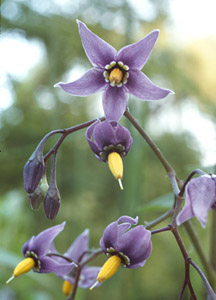
Bittersweet Nightshade, Nightshade or Potato family (Solanaceae), Alien

 |
In spite of the nightshade name, the nightshades at the Reservoir are not the true "deadly nightshade"--or belladonna (Atropa belladonna)--of literature and lore. Belladonna grows in central and southern Europe and is rarely found in North America. It contains a poisonous chemical, atropine, and all parts of it are poisonous. In contrast, the nightshades at the Reservoir have histories of medicinal use, although their berries or other parts may cause a stomachache. To be on the safe side, children should not put the berries in their mouths.
Bittersweet nightshade may get its name from the taste--first bitter, then sweet--that comes from chewing the leaves. A substance called dulcamarine is responsible for this experience. The plant also contains small quantities of another chemical, solanine, which contributes to various effects that have been considered both medicinal and poisonous.
The small flowers of bittersweet nightshade have a distinctive look, with turned-back petals and a cone-shaped beak. Gardeners may notice that they are similar to flowers of the tomato plant (Lycopersicum esculentum), which is in the same family, the nightshade or potato family (Solanaceae). (Tomatoes were once believed to be poisonous.) Other plants in this family include the potato (Solanum tuberosum), the eggplant (Solanum melongena), and tobacco (genus Nicotiana).
Nightshade flowers do not produce nectar. Insects feed on the pollen instead. The flowers often point
downward, and bees hang upside-down on the flowers and vibrate their wing muscles to shake pollen out
of the beak.

Daisy Fleabane, Composite or Daisy family (Compositae), Native


|
In spite of its name, daisy fleabane is not useful for killing or chasing away fleas. Its name may be due to its similarity to a European plant, true common fleabane (Inula dysenterica). People used to burn this plant so the smoke would drive away fleas and other insects.
Like most plants in the composite or daisy family, the flowerheads of daisy fleabane are dense clusters
of many small flowers. The 40-70 flat, thin, white "petals" of daisy fleabane are actually separate
flowers of one type. They surround a center consisting of numerous tubular yellow flowers of another
type. Such closely packed flowers are readily pollinated by insects, which may touch hundreds of flowers
as they move across the flowerheads, looking for nectar. The flowerheads typically produce abundant seeds,
which, in the case of daisy fleabane, were once likened to fleas--perhaps another source of the name.
Easy pollination and abundant seeds give composites such as daisy fleabane an advantage in the competitive
world of flowering plants, helping to explain why daisy-like flowers are so common and widespread.
Mortherwort, Mint family, (Labiatae), Alien
 |
 |
 |
Stands of motherwort (Leonurus cardiaca) start to show their clusters of small purple blossoms in late June at the Reservoir and continue to bloom well into July. Motherwort is a tall member of the mint family, growing to five feet or so. Like other mints, it has a square stem, clusters of tiny tubular flowers in the crooks where leaf stalks join the stem, and a pungent aroma.
Originally imported for medicinal uses, motherwort quickly escaped from early colonial gardens and spread
rapidly and widely in North America. It was used to treat heart ailments and was respected as a remedy
for "women's complaints," as its name might suggest. "Wort" is simply an old-fashioned word for
"plant," derived from Old English, and has nothing to do with warts. Motherwort is now often regarded
as a weed, rather than a garden staple.
| show TOC frame | Table of Contents | 
|
| Home / Contact | ||
Copyright © Anne A. Reid, 1999-2002. Photographs copyright © Garry K. Kessler, 1999-2002. | ||